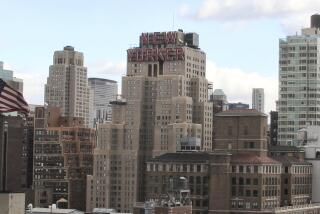Agents--and Others--Think Twice About Relocating to Manhattan : To FBI, New York Is Not on Most Wanted List
NEW YORK â Like most FBI agents, Robert Brannon spends his day doing legwork, making contacts, developing leads.
But Brannon is on the tail of mortgage officers and real estate agents, not mobsters or terrorists, and his most wanted list consists of affordable suburban homes within two hours of Manhattan.
His assignment: find housing for FBI agents transferring to New York.
The FBI is one of many organizations finding it harder and harder to persuade employees to take assignments in a city with the highest cost of living on the U.S. mainland and levels of dirt, noise and congestion to match.
Rejection Rate High
That big transfer to the New York office is being regarded more warily by the organization man--and the organization woman. Homequity Inc., the nationâs largest corporate relocation firm, says 50% of transfer offers to New York are rejected, compared to 25% two years ago.
When 143 corporations were asked to list the three areas to which transferees expressed the most resistance, New York was named by 73%; the next highest, Los Angeles, was named by only 39%, followed by Boston (38%) and San Francisco (31%).
Although the transfer was once an accepted part of the trip up the organizational ladder, Americans have become more resistant to such moves, particularly if the destination is an expensive urban area.
This resistance is most apparent in New York, with its peerless concentration of corporate headquarters, government offices and nonprofit agencies.
About one-fifth of the nationâs 1,000 largest companies have headquarters in the New York region, 121 of them in the city itself. Chicago, the second most popular corporate base, has 37.
16 Firms Plan to Move
But last year 16 companies announced plans to leave New York, including J. C. Penney and Mobil Oil, both of whom cited employee reluctance to transfer here as one reason for their move.
For government and nonprofit agencies, New York is even tougher to sell.
Even though New York offers what the FBIâs Brannon calls âsome of the best work in the organization,â in areas such as organized crime and counterintelligence, it is the last choice among the nationâs FBI agents, and the office is short about 100 agents.
When the Coast Guard reorganized its civilian work force last year and asked more than 100 employees to transfer to New York, all but a few refused.
Itâs easy to see why. Runzheimer International, relocation consultants, says the $50,000 it takes to support an executive with a spouse and two children for a year in suburban Tampa, Fla., or Columbus, Ohio, would have to increase to $70,000 to do the same in New York. Boston, the next priciest region, is far behind at $62,000.
New York has $7 movie tickets (at most Manhattan theaters), $22 parking tabs (for 10 hours at a mid-town garage), and the most expensive regional housing market in the United States, barring the costly outposts of Alaska and Hawaii.
Real Estate Sky High
In the first quarter of 1988, the average price of a two-bedroom apartment south of 96th Street, a traditional real estate boundary line of personal and financial security, was $468,000. The median price of a single family home in the metropolitan region was $186,600, compared to a national figure of $88,100. That gap, relocation experts say, reflects the growing disparity between living costs in larger and smaller cities.
âThe price swings are so huge now,â said Michael Schell, president of Moran, Stahl & Boyer, relocation consultants. âThe differences were always there, but the magnitude has become so enormous it would seem to make relocation impossible in some cases.â
One result is horrendous commutes, as late entrants to New Yorkâs overheated housing market are forced to seek less expensive shelter farther and farther from work.
The daily odyssey of Frank Carlin, an executive at Catholic Relief Services, illustrates one reason for the agencyâs decision to move to Baltimore next year.
Moves to New Jersey
When Carlin was transferred to New York two years ago, he settled in the central New Jersey town of Plainsboro because he couldnât afford housing closer to the relief agencyâs offices in Manhattan.
He must leave home at 6:40 each morning, drive to the train station, ride to Manhattan, take the subway uptown and walk 15 minutes to his office. By the time he reverses the process, it often is 9:30 or 10 p.m.
If Catholic Relief Services had not decided to move, âI couldnât continue it much longer,â he said. âIt really has taken a toll on our family. I barely see my kids.â
Beyond housing, New York has âimage problems to be overcome,â Schell admitted.
Lance Barclay, a Moran, Stahl vice president, is often reminded of that as he flies into New York. âWeâre all admiring this magnificent view of Manhattan, and somebody will say something like, âSomebody down there is getting mugged.â You donât feel the same sort of resistance to L.A. or San Francisco.â
Many Americans, he said, regard the city as âa place where the pace is too fast and the people are too arrogant.â
Although many approaches to overcoming relocation resistance are tried, âit generally boils down to dollars,â said Joseph Sasanno of Homequity. âThe limo that meets you at the airport is window dressing.â
No Limo, No Dollars
Federal workers, however, get neither the limo nor the dollars; the government pays civil servants in New York no more than elsewhere, although a trial cost-of-living raise for New York has been proposed in Congress.
Corporations increasingly offer assistance in selling the old house and buying a new one and in getting a mortgage for the latter. Many companies also offer bonuses, loans, salary adjustments, housing allowances and miscellaneous moving budgets.
When he was recruiting for American Express in Manhattan, Barclay would try a simpler approach âto get people to see the more positive side of things.â
If it were a nice day, he would take his visitor outside, buy a couple of beers and franks, and conduct the interview on the Staten Island Ferry.
âOn that ferry, on a good day, with that view of Manhattan--you got âem.â
More to Read
Sign up for Essential California
The most important California stories and recommendations in your inbox every morning.
You may occasionally receive promotional content from the Los Angeles Times.










